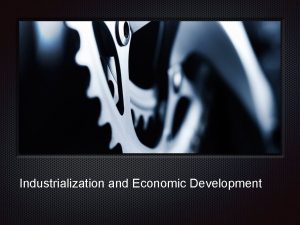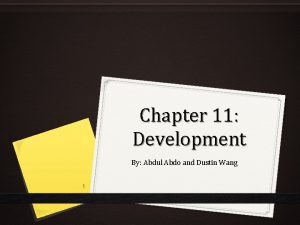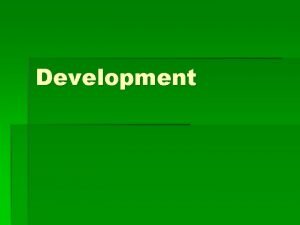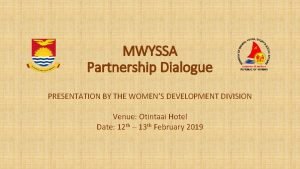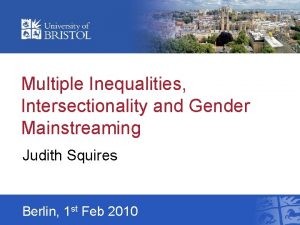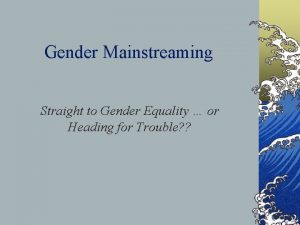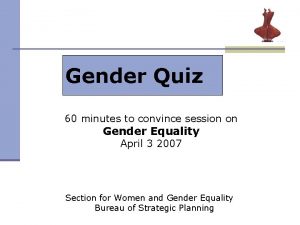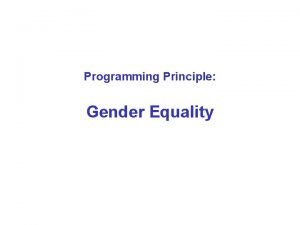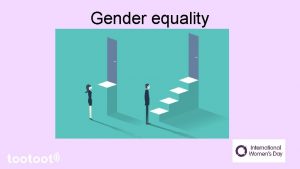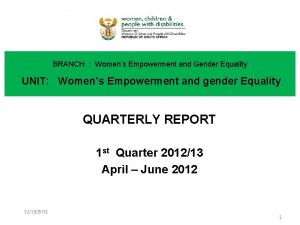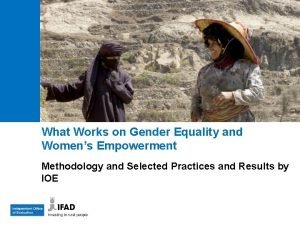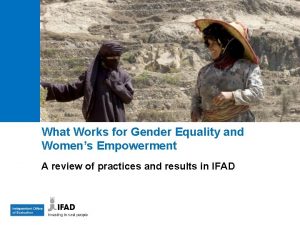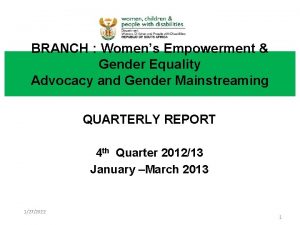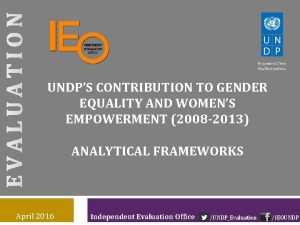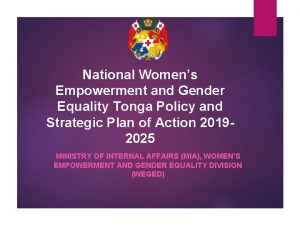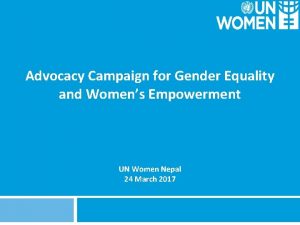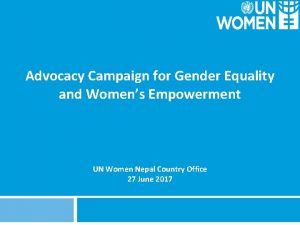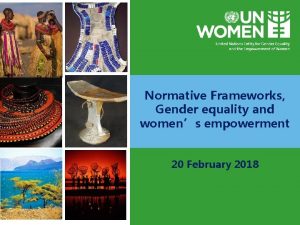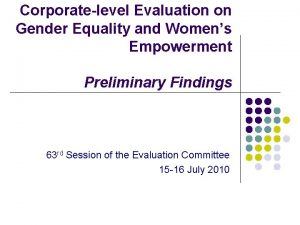What Works on Gender Equality and Womens Empowerment












- Slides: 12

What Works on Gender Equality and Women’s Empowerment Methodology and Selected Practices and Results by IOE

Synthesis objectives and scope • Objectives - Identify gender-transformative practices that can inform future IFAD interventions under Agenda 2030 - Identify key factors enabling (or hindering) GEWE • Scope - Focus on IFAD lending operations - Practices documented in IOE evaluations since 2011 • Systematic review - Extracting practices and results from a representative sample of 57 evaluations

Data collection strategy -3 -

Analysis • To. C as analytical framework • Synthesising evidence from matrices according to practices and results • Quantitative analysis of transformation scores • 33 case studies, to understand factors for success and failure and context • Lessons learned from other partners -4 -

IFAD Theory of Change on GEWE

hancing women’s. TOTAL and men’s Creating awareness an enabling and Reducing environment confidence time Access poverty to resources and opportunities GEWE Practices Number of GEWE practices in the sample 0 1. a Inclusive financial services 1. b Engagement in IGA 1. c Backyards and home gardens 1. d Technical and vocational training 1. e Participation in markets and value chains 1. f Off-farm Employment opportunities 2. a Infrastructure 2. b Labour-saving technologies and practices 2. c Child care support 3. a Policy engagement at national and local levels 3. b Representation and voice in local governance institutions 3. c Legal rights on land forests 4. a. Breaking gender roles and stereotypes 4. b. Working with men 4. c. Functional skills training (literacy etc. ) 5 10 15 20 25

GEWE effectiveness quadrant More common More effective (consistent results evidenced) Less effective (mixed results evidenced) Breaking gender roles and stereotypes Inclusive financial services Representation and voice in local governance institutions Infrastructure Functional skills training Less common Labour-saving technologies and practices Child care support Off-farm employment Backyard and home gardens Establishing value chains, access to markets Promotion of IGAs Technical and vocational training Policy engagement at national and local levels Working with men Legal rights on land forests

Key lessons • Empowering and gender transformative approaches need to be integrated into project design. • Multiple and complementary practices are more likely to facilitate changes in gender roles and relations. • Working with men as gatekeepers of customary practices is critical. • Participatory approaches can facilitate gender-inclusive outcomes, if combined with specific strategies to target women. • Promoting unconventional and new roles for women helps shifting mindsets and commonly held beliefs.

Key conclusions • Guidance by IFAD gender policy and action plan ensured that interventions address key GEWE issues. • IFAD has addressed root causes of gender inequality and women’s powerlessness, in particular illiteracy, exclusion from access to resources and limited social capital. • Explicit specific strategies to target women critical to ensuring that women benefit equally and that their strategic needs are addressed. • Diversity of women along lines of ethnicity, religion, and life cycle, not sufficiently targeted. • GEWE outcomes and impacts not well documented.

Implications for IOE • Improve documentation of GEWE outcomes and impacts, using methodologies for measuring gender transformative changes (e. g. case studies and participatory and qualitative research)

UN Guidance for Evaluation • Granular data to monitor vulnerable and hard to reach populations (e. g. migrants, youth, women, displaced persons, ethnic minorities) • Evaluation design and approach to address relevant human rights and gender equality aspects through evaluation criteria, questions, data collection and analysis • Evaluation process –inclusive and diverse stakeholder engagement; adaptive process to accommodate complexity • Evaluation team – appropriate gender balance and geographical diversity. * UNEG norms and standards for evaluation 2016

Thank you - 12 -
 Gender empowerment measure
Gender empowerment measure The united states is an _____. ldc mdc
The united states is an _____. ldc mdc Gender empowerment measure
Gender empowerment measure Gender empowerment measure
Gender empowerment measure Gender empowerment measure
Gender empowerment measure Simple definition of development
Simple definition of development Strategic gender needs and practical gender needs
Strategic gender needs and practical gender needs Mwyssa
Mwyssa Rhetorical questions about gender equality
Rhetorical questions about gender equality Gender equality definition
Gender equality definition What is gender equality answer
What is gender equality answer Methodology of gender equality
Methodology of gender equality Kothari commission aims
Kothari commission aims


